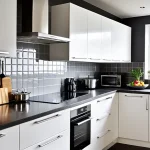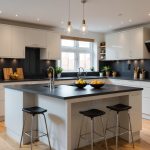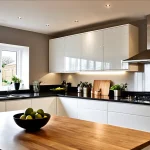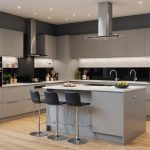Elements That Define the Unique Atmosphere of UK Kitchen Bars
The atmosphere of UK kitchen bars is a carefully crafted experience shaped by strategic interior design. Interior design here goes beyond aesthetics; it sets the mood by blending modernity with rustic charm, often incorporating exposed brick walls and wooden accents that resonate warmth and authenticity.
Lighting plays a pivotal role in enhancing the UK kitchen bars atmosphere. Soft, warm light fixtures and cleverly placed accent lights create intimate spaces ideal for conversations, while adjustable lighting allows venues to shift from casual day settings to vibrant evening vibes seamlessly. This flexibility in lighting design directly influences guests’ comfort and engagement.
Also to see : What Are the Key Elements of a Successful UK Kitchen Restaurant Bar Design?
Seating arrangements are diverse and purposeful, ranging from cozy booths for small groups to communal tables that promote social interaction. These varied setups cater to different group sizes and foster a welcoming environment unique to UK kitchen bars.
Decor choices also infuse local character, often featuring artwork or vintage items reflecting British heritage, which adds layers of storytelling and personality to the space. Such details transform ordinary dining experiences into memorable social events, defining the distinctive charm of UK kitchen bars.
Have you seen this : How do UK kitchens maintain hygiene standards during busy hours?
Open-Kitchen Concepts and Menu Presentation
Open kitchen UK bars have become a popular trend, offering patrons a more immersive culinary experience. This layout increases transparency, allowing guests to observe the cooking process firsthand. The sight and sounds of chefs at work create a dynamic atmosphere, enhancing engagement and anticipation. Customers often feel more connected to their food, which builds trust and excitement.
Menu presentation in these venues is carefully designed to complement the open kitchen. Clear, visually appealing menus help set expectations and highlight signature dishes. Well-structured menus often feature descriptions that evoke sensory experiences, further drawing patrons into the scene unfolding before them. This thoughtful menu design contributes significantly to the overall ambience.
Interaction between chefs, kitchen staff, and patrons is a hallmark of open kitchen UK bars. Chefs can showcase their skills directly, answer questions, and receive instant feedback. This two-way engagement enriches the dining occasion, making it memorable beyond just the food itself. Such environments transform eating out into a multifaceted experience that combines taste, sight, and social connection.
Music and Soundscapes in UK Kitchen Bars
Sound design in UK kitchen bars plays a crucial role in shaping the overall bar ambiance. Carefully curated music playlists are essential for setting the mood; whether it’s a lively evening or a relaxed brunch, the right music can enhance patrons’ enjoyment. For example, a mix of jazz or soft indie tunes can create a welcoming atmosphere that invites conversation without overwhelming it.
Acoustic planning is equally important. Good sound design ensures that background music complements rather than competes with dining and conversation. This often involves managing speaker placement and volume levels, so the music feels natural and unobtrusive. Effective soundscapes avoid excessive noise, which can deter guests from staying longer or engaging deeply.
Influence of music in kitchen bars extends beyond simple background noise. It shapes the customer experience by affecting emotions and social interactions, making patrons feel more connected to the space. When done right, soundscapes in UK kitchen bars contribute to memorable visits, encouraging repeat business and positive word-of-mouth.
Staff Interaction and Personalised Service
A vital component of outstanding bar hospitality lies in effective staff interaction. Approachable and knowledgeable staff create a welcoming atmosphere, encouraging guests to return. Friendly engagement helps patrons feel valued, and staff awareness of menu details, drink pairings, and guest preferences enhances the overall experience.
In many UK kitchen bars, personalised service goes beyond standard bartending. Staff often remember regulars’ favourite drinks or dietary needs, tailoring recommendations accordingly. For example, a bartender might suggest a craft cocktail using local ingredients based on a guest’s previous choices. Such customisation builds rapport and deepens customer satisfaction.
Staff also play crucial roles in fostering a warm environment—from greeting guests promptly to handling queries efficiently. Their ability to read the room and adjust interactions ensures a balance between professional service and genuine friendliness. This personalised approach differentiates kitchen bars, making visits feel unique and memorable, ultimately boosting loyalty and positive word-of-mouth.
Case Studies: Notable UK Kitchen Bars and Their Signature Atmospheres
Exploring notable UK kitchen bars reveals how diverse concepts shape the customer experience in remarkable ways. Take the Social Eating House in London, for example. This venue excels with its open-kitchen showcase, inviting guests to witness chefs in action. This transparency fosters a lively, immersive atmosphere, encouraging interaction and sparking curiosity about the culinary process.
In Manchester, The Botanist stands out with its creative concept. It combines botanical-inspired decor with a menu emphasizing unique, plant-based cocktails and flavors. This innovation enhances the customer experience, making it memorable through both taste and aesthetics.
Liverpool’s The Florist offers a distinctive decor that transforms dining into a floral fantasy. Its bold use of fresh flowers and pastel tones creates a relaxing yet vibrant environment. This visual appeal complements the culinary offerings, deepening the guest’s emotional connection to the space and food.
Each case study demonstrates that notable UK kitchen bars leverage design and concept to offer more than just food—they curate atmospheres that engage senses and elevate enjoyment.
Distinctions Between UK Kitchen Bars and Traditional Bars or Restaurants
Kitchen bars in the UK stand apart from traditional bars and restaurants by blending food preparation and social interaction in a unique setting. Unlike conventional venues, kitchen bars emphasize an open kitchen design, allowing patrons to observe chefs at work. This transparency fosters a lively and engaging atmosphere that traditional bars typically lack.
Service at kitchen bars tends to be more personal and interactive, with bartenders and chefs often serving directly at the counter, breaking down barriers between staff and customers. In contrast, traditional bars usually separate serving areas and kitchens, creating a more formal and less intimate environment.
Customers perceive kitchen bars as vibrant and innovative spaces, often valuing the direct engagement with food preparation and the informal yet sophisticated vibe. Such unique features enhance patron loyalty, as visitors appreciate the blend of casual dining and a social drinking experience. This fusion boosts satisfaction by providing more than just food or drink—offering a memorable, multi-sensory experience found less commonly in traditional venues.





